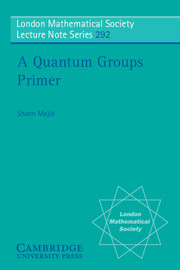Book contents
- Frontmatter
- Contents
- Preface
- 1 Coalgebras, bialgebras and Hopf algebras. Uq(b+)
- 2 Dual pairing. SLq(2). Actions
- 3 Coactions. Quantum plane A2q
- 4 Automorphism quantum groups
- 5 Quasitriangular structures
- 6 Roots of unity. uq(sl2)
- 7 q-Binomials
- 8 Quantum double. Dual-quasitriangular structures
- 9 Braided categories
- 10 (Co)module categories. Crossed modules
- 11 q-Hecke algebras
- 12 Rigid objects. Dual representations. Quantum dimension
- 13 Knot invariants
- 14 Hopf algebras in braided categories. Coaddition on A2q
- 15 Braided differentiation
- 16 Bosonisation. Inhomogeneous quantum groups
- 17 Double bosonisation. Diagrammatic construction of uq(sl2)
- 18 The braided group uq(n+). Construction of uq(g)
- 19 q-Serre relations
- 20 R-matrix methods
- 21 Group, algebra, Hopf algebra factorisations. Bicrossproducts
- 22 Lie bialgebras. Lie splittings. Iwasawa decomposition
- 23 Poisson geometry. Noncommutative bundles. q-Sphere
- 24 Connections. q-Monopole. Nonuniversal differentials
- Problems
- Bibliography
- Index
1 - Coalgebras, bialgebras and Hopf algebras. Uq(b+)
Published online by Cambridge University Press: 18 January 2010
- Frontmatter
- Contents
- Preface
- 1 Coalgebras, bialgebras and Hopf algebras. Uq(b+)
- 2 Dual pairing. SLq(2). Actions
- 3 Coactions. Quantum plane A2q
- 4 Automorphism quantum groups
- 5 Quasitriangular structures
- 6 Roots of unity. uq(sl2)
- 7 q-Binomials
- 8 Quantum double. Dual-quasitriangular structures
- 9 Braided categories
- 10 (Co)module categories. Crossed modules
- 11 q-Hecke algebras
- 12 Rigid objects. Dual representations. Quantum dimension
- 13 Knot invariants
- 14 Hopf algebras in braided categories. Coaddition on A2q
- 15 Braided differentiation
- 16 Bosonisation. Inhomogeneous quantum groups
- 17 Double bosonisation. Diagrammatic construction of uq(sl2)
- 18 The braided group uq(n+). Construction of uq(g)
- 19 q-Serre relations
- 20 R-matrix methods
- 21 Group, algebra, Hopf algebra factorisations. Bicrossproducts
- 22 Lie bialgebras. Lie splittings. Iwasawa decomposition
- 23 Poisson geometry. Noncommutative bundles. q-Sphere
- 24 Connections. q-Monopole. Nonuniversal differentials
- Problems
- Bibliography
- Index
Summary
Quantum groups today are like groups were in the nineteenth century, by which I mean
– a young theory, abundant examples, a rich and beautiful mathematical structure. By ‘young’ I mean that many problems remain wide open, for example the classification of finite-dimensional quantum groups.
– a clear need for something like this in the mathematical physics of the day. In our case it means quantum theory, which clearly suggests the need for some kind of ‘quantum geometry’, of which quantum groups would be the group objects.
These are algebra lectures, so we will not be able to say too much about physics. Suffice it to say that the familiar ‘geometrical’ picture for classical mechanics: symplectic structures, Riemannian geometry, is all thrown away when we look at quantum systems. In quantum systems the classical variables or ‘coordinates’ are replaced by operators on a Hilbert space and typically generate a noncommutative algebra, instead of a commutative coordinate ring as in the classical case. There is a need for geometrical structures on such quantum systems parallel to those in the classical case. This is needed if geometrical ideas such as gravity are ever to be unified with quantum theory.
From a mathematical point of view, the motivation for quantum groups is:
– the original (dim) origins in cohomology of groups (H. Hopf, 1947); an older name for quantum groups is ‘Hopf algebras’
– q-deformed enveloping algebra quantum groups provide an explanation for the theory of q-special functions, which dates back to the 1900s. They are used also in number theory.
- Type
- Chapter
- Information
- A Quantum Groups Primer , pp. 1 - 8Publisher: Cambridge University PressPrint publication year: 2002

